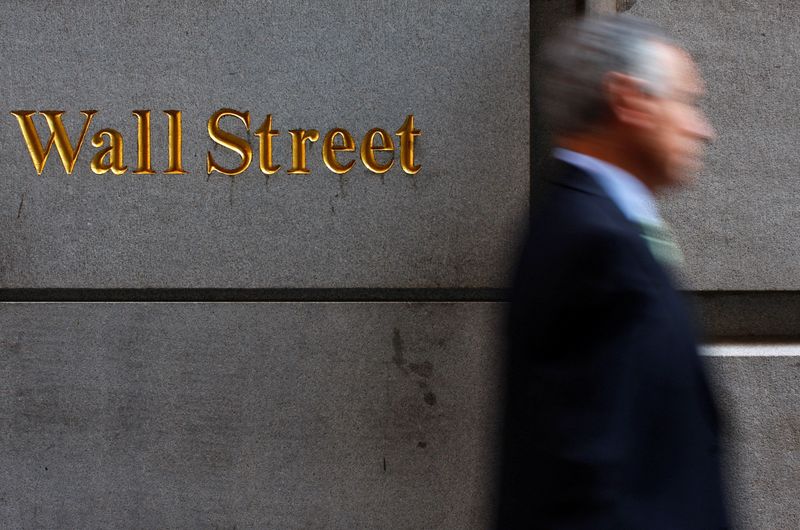 © Reuters. FILE PHOTO: A man walks along Wall Street in New York September 18, 2008. REUTERS/Eric Thayer/File Photo
2/2
© Reuters. FILE PHOTO: A man walks along Wall Street in New York September 18, 2008. REUTERS/Eric Thayer/File Photo
2/2
By Stephen Culp
NEW YORK (Reuters) - The S&P 500 index closed modestly lower on Monday, largely recovering from a sharp sell-off, as U.S. plans to close its Kyiv embassy in Ukraine sent simmering geopolitical tensions to a boil.
All three major U.S. stock indexes dropped sharply after U.S. Secretary of State Antony Blinken announced the relocation of U.S. diplomatic operations to western Ukraine, in a possible sign of an imminent Russian invasion.
Adding to uncertainty, Ukraine President Volodymyr Zelenskiy said Wednesday would be the day of the attack. Ukrainian officials later said Zelenskiy was not predicting an attack on that day but responding with skepticism to foreign media reports.
By the closing bell, the Dow Jones Industrial Average joined the S&P 500 in negative territory, while the Nasdaq Composite Index ended essentially unchanged.
Ongoing concerns over aggressive policy from the Federal Reserve also have contributed to recent market volatility.
"There's a lot of cross currents, a lot of potential negatives in the markets," said Paul Nolte, portfolio manager at Kingsview Asset Management in Chicago.
France's foreign minister said everything was in place for a Russian attack and that Europe was ready to impose massive sanctions if it happened.
Geopolitical anxieties have been simmering in recent weeks as negotiators scrambled to find a diplomatic path forward as Russia amassed troops along the Ukrainian border.
Still, market fallout due to geopolitical turmoil tends to be fleeting, according to historical data.
"History actually tells investors that military and terrorist strikes tend to have short-lived shocks because they do not result in global recession," said Sam Stovall, chief investment strategist of CFRA Research in New York.
Adding to the uncertainty were increasingly hawkish comments from St. Louis Federal Reserve President James Bullard. He reiterated his call for a faster rake hike timeline and said the central bank's "credibility is on the line" in its battle against rising prices.
Recent data showed U.S. inflation at its hottest level in decades, ratcheting up concerns that the Fed could begin hiking key interest rates more aggressively than many had anticipated.
"The market is being felled by a combination punch, with Bullard's comments as well as increased rhetoric about the imminent invasion by Russia," Stovall added.
The Dow Jones Industrial Average fell 171.89 points, or 0.49%, to 34,566.17; the S&P 500 lost 16.97 points, or 0.38%, at 4,401.67; and the Nasdaq Composite dropped 0.24 points, or 0%, to 13,790.92.
Ten of the 11 major sectors in the S&P 500 closed in negative territory, with energy stocks suffering the largest percentage drop. Consumer discretionary and communications services were the only gainers.
Fourth-quarter earnings season is approaching the home stretch, with 358 of the companies in the S&P 500 having reported. Of those, 78% have beat consensus estimates, according to Refinitiv data.
Nvidia (NASDAQ:NVDA) Corp and Walmart (NYSE:WMT) Inc are among the high profile companies posting results this week.
Tesla (NASDAQ:TSLA) Inc advanced 1.8% after Chinese auto industry authorities announced the electric car maker sold nearly 60,000 China-made vehicles in January.
Drugmaker Biohaven shares rose 2.2% following positive topline trial results in the migraine treatment rimegepant. Pfizer Inc (NYSE:PFE) acquired the overseas marketing rights to the drug in November.
But Pfizer dropped 1.9%, joining other COVID vaccine makers in the red.
Moderna (NASDAQ:MRNA) Inc tumbled 11.7% and Johnson & Johnson (NYSE:JNJ) dipped 1.3%. Novavax (NASDAQ:NVAX) Inc, which on Monday submitted an application to Switzerland's drugs regulator for approval of its COVID vaccine, dropped 11.4%.
Declining issues outnumbered advancers on the NYSE by a 2.80-to-1 ratio; on Nasdaq, a 2.17-to-1 ratio favored decliners.
The S&P 500 posted one new 52-week high and 18 new lows; the Nasdaq Composite recorded 24 new highs and 246 new lows.
Volume on U.S. exchanges was 11.32 billion shares, compared with the 12.67 billion average over the last 20 trading days.

